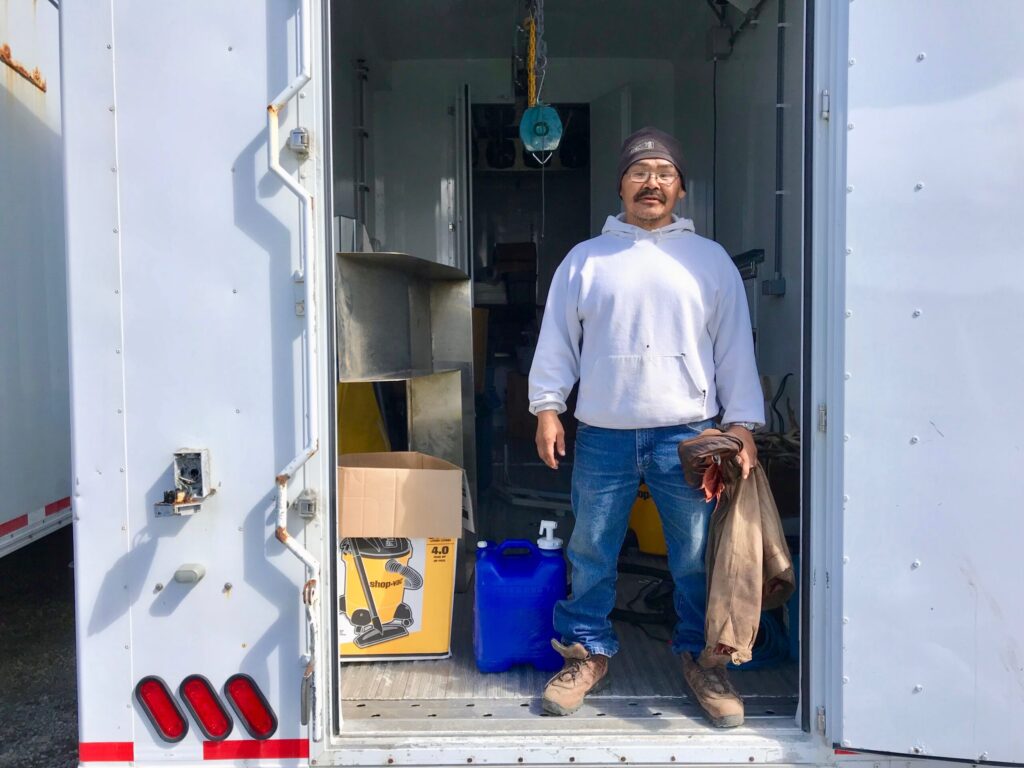In a few months, the ice-classed research vessel Sikuliaq, owned by the National Science Foundation, will be equipped with about a half dozen Arctic Native ice testing sticks as part of the ship’s safety outfit.
“It’s a multi-tool. Sometimes there’s a hook on the end for retrieving things, and the other end is used for poking the ice. It could be a harpoon with a rib bone, or some type of bone sticking out on the other end to test the ice,” said Brandon Ahmasuk, subsistence director at Kawerak. “Obviously, if it goes through, you don’t want to step there.”
Ahmasuk said it’s a highly valued safety tool for Alaskans who live in coastal communities and venture onto the ice for hunting in the winter. By testing the ice in their path with the stick, they can prevent accidentally falling through the weaker patches. He said his family always takes this tool with them on the ice because of its many functions.
“If you do happen to fall through, hopefully you can catch yourself before you fall past your waist and pull yourself back out,” said Ahmasuk. “If you do happen to fall all the way through, it’s still there, so you can pull yourself up like you’re doing a pull up. It’s a safety tool. They almost always have a dual function—whether it’s a harpoon, a retrieving hook, or a mooring hook.”
Ahmasuk said, fortunately, he has never fallen into the water, but he’s seen it happen to others, and it can be pretty terrifying.
“One of my brothers did fall in, and he said immediately it just took his breath away. He couldn’t breathe,” said Ahmasuk. “I mean, within a second he was able to pull himself out. A lot of times, individuals are out seal hunting or walrus hunting, and they’re miles and miles from the nearest town or village. So, if you do fall in, you’re going to be soaking wet. More than likely, you’re not going to make it back to wherever you came from because, within a matter of minutes, hypothermia is going to set in, and you’re going to freeze to death.”

The Sikuliaq is not an icebreaker, but it is an ice-classed vessel capable of breaking through up to two-and-a-half feet of ice. The vessel will operate in ice during some of its research missions in the Arctic—and scientists may be walking out on to the ice to collect data samples, which means they must be prepared for potentially dangerous situations.
Daniel Oliver is the marine superintendent at UAF’s Seward Marine Center. Oliver was in the U.S. Coast Guard before taking his current job at the Seward Marine Center, and he said it was through visits to coastal communities aboard Coast Guard icebreakers that he realized how functional and necessary the tool is. After consulting with Gay Sheffield, Marine Advisory agent in Nome, he decided to request those ice testing sticks as safety tools for the Sikuliaq.
“I found it was a pretty universal tool within the coastal communities, [with the people] that spend a good portion of their lives out on the ice with subsistence hunting,” said Oliver. “From talking with a number of folks from the villages, it certainly made sense to me. Which is why, when we were looking at what we were going to carry on board Sikuliaq for equipment, having this capability aboard made sense to me.”
Perry Pungowiyi is a craftsman in Savoonga, a member of the National Science Foundation Sikuliaq Oversight Committee and alternate commissioner on the Alaska Eskimo Whaling Commission for Savoonga. Pungowiyi will be making the sticks with materials Sheffield and Oliver have sent over to St. Lawrence Island. He said the tools are “time-tested by ice walkers of Alaska.” In Siberian Yupik, the name for the ice testing stick is “unghaq.”
Oliver said he hopes someone from Savoonga who is part of the ship’s science oversight committee will be able to join the Sikuliaq crew at some point during ice trials, to share knowledge about the ice testing sticks and Bering Sea ice conditions.
The Sikuliaq, which is home-ported in Seward, will be used by U.S. and international scientists. Its first funded science trip this fall will be in the western Hawaiian island chain.
Image at top: Two people stand on the ice with their testing sticks, hooks visible at the top. The hook could be used to grab onto an article of clothing if someone fell into the water. Photo courtesy of Gay Sheffield.







